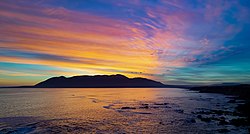Antofagasta Region
The II Antofagasta Region (Spanish: Región de Antofagasta) is one of Chile's 15 first order administrative divisions. It is the second-largest region of Chile. To the east it borders Bolivia and Argentina.
Antofagasta Region
Región de Antofagasta | |
|---|---|
 Morro Moreno National Park | |
 Map of Antofagasta Region | |
| Coordinates: 23°38′39″S 70°24′39″W / 23.64417°S 70.41083°W | |
| Country | |
| Capital | Antofagasta |
| Provinces | Tocopilla, El Loa, Antofagasta |
| Government | |
| • Intendant | Marco Antonio Díaz (RN) |
| Area | |
| • Total | 126,049.1 km2 (48,667.8 sq mi) |
| • Rank | 2 |
| Highest elevation | 6,723 m (22,057 ft) |
| Lowest elevation | 0 m (0 ft) |
| Population (2017 census)[1] | |
| • Total | 599,335 |
| • Rank | 9 |
| • Density | 4.8/km2 (12/sq mi) |
| ISO 3166 code | CL-AN |
| HDI (2019) | 0.875[2] very high |
| Website | Official website (in Spanish) |
The capital of the region is the port city of Antofagasta.
History
changeThe area away from the coast was populated by the Atacama people around the great dry salt lake called Salar de Atacama, the river basin of the Loa and valleys and oasis across the altiplano, with the most important settlement being the town of San Pedro de Atacama.
The region used to be Bolivian until the War of the Pacific started in 1879.
Geography
changeThe Antofagasta region borders the Tarapacá region to the north, Bolivia to the northeast, Argentina to the southeast, the Atacama region to the south and the Pacific Ocean to the west.[3]
The Llullaillaco volcano is the region's highest elevation at 6,739 m (22,110 ft); it is on the border with Argentina.
The only river of the region is the Loa river, the longest river of Chile, with a length of 440 km (273 mi).[4]
Climate
changeThe climate of the region is extremely arid (a desert climate) but somewhat milder near the coast and the highest mountains.
The three types of desert climate in the region are,[3] (with the Köppen climate classification)
- Coastal Desert Climate (BWn), along the coast.
- Normal Desert Climate (BW)
- Desert Climate in High Mountains (BWh), found in mountains over 3,000 m (9,843 ft) high.
Nearly all of the region does not have any vegetation except close to the Loa river or at oases such as San Pedro de Atacama.
Population
changeAs of 2015[update], there were (estimated) 622,640 persons living in the region,[5] for a population density of 4.9 inhabitants/km².
The largest cities (2002 census) of the region are the capitals of the three provincesː Antofagasta (285,255 inhabitants), Calama (126,135 inhabitants) and Tocopilla (23,352 inhabitants).[3]
Administration
changeThe Antofagasta region is divided in three provincesː
| Provinces | Capital | Code | Comunas | Area (km²)[3] |
Population 2002[3] |
|---|---|---|---|---|---|
| Antofagasta (021) |
Antofagasta | 02101 | 1 Antofagasta | 30,718.1 | 296,905 |
| 02102 | 2 Mejillones | 3,803.9 | 8,418 | ||
| 02103 | 3 Sierra Gorda | 12,886.4 | 2,356 | ||
| 02104 | 4 Taltal | 20,405.1 | 11,100 | ||
| Total of the Antofagasta province | 67,813.5 | 318,779 | |||
| El Loa (022) |
Calama | 02201 | 5 Calama | 15,596.9 | 138,402 |
| 02202 | 6 Ollagüe | 2,963.9 | 318 | ||
| 02203 | 7 San Pedro de Atacama | 23,438.8 | 4,969 | ||
| Total of the El Loa province | 41,999.6 | 143,689 | |||
| Tocopilla (023) |
Tocopilla | 02301 | 9 Tocopilla | 4,038.8 | 23,986 |
| 02302 | 8 María Elena | 12,197.2 | 7,530 | ||
| Total of the Tocopilla province | 16,236.0 | 31,516 | |||
| Total of the region | 126,049.1 | 493,984 | |||
Related pages
changeReferences
change- ↑ 1.0 1.1 "Antofagasta Region". Government of Chile Foreign Investment Committee. Retrieved 13 March 2010.[permanent dead link]
- ↑ "Sub-national HDI - Area Database - Global Data Lab". hdi.globaldatalab.org. Retrieved 26 October 2021.
- ↑ 3.0 3.1 3.2 3.3 3.4 "Región de Antofagasta" (PDF). Instituto Nacional de Estadísticas. Archived from the original (PDF) on 3 June 2016. Retrieved 23 July 2016.
- ↑ "Cuenca del río Loa" (PDF) (in Spanish). Ministerio de Obras Públicas - Dirección General de Aguas. Archived from the original (PDF) on 24 September 2015. Retrieved 24 July 2016.
- ↑ "Población país y regiones - Actualización 2002-2012 y Proyección 2013-2020" (XLS) (in Spanish). Instituto Nacional de Estadísticas (INE). 4 September 2014. Retrieved 23 July 2016.
Other websites
change- Territorial division of Chile (in Spanish)
- Official website of the Local Government (in Spanish)
| Regions of Chile | |
|---|---|
| Arica y Parinacota | Tarapacá | Antofagasta | Atacama | Coquimbo | Valparaíso | O'Higgins | Maule | Ñuble | Bío Bío | La Araucanía | Los Ríos | Los Lagos | Aysén | Magallanes y la Antártica Chilena | RM Santiago | |

